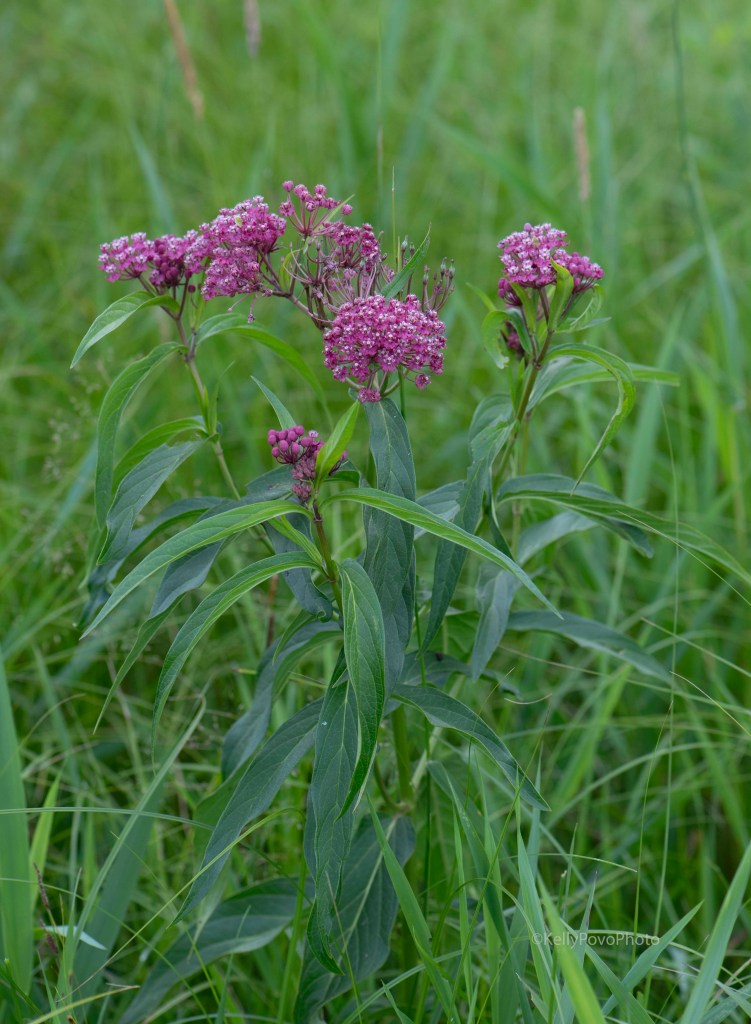July 8, 2023
Author: Phyllis Root
Photographer: Kelly Povo
We’ve been looking for specific flowers blooming in specific places when our two different schedules allow, which only works when the flowers cooperate. This year when bloom times seem less predictable than usual, we’ve come to expect disappointments along with successes, so this past weekend in the absence of flowers to count we started counting disappointments.
Disappointment number 1: The roadside where we’d seen showy milkweed blooming last summer shows no signs this year of showy, or of almost any other, milkweed. Where did they go? We don’t know. We only know they aren’t where we’d seen them before.
Disappointment number 2: The tessellated rattlesnake plantain leaves and last year’s flower stalks that we’d seen in Badoura Jack Pine Woodland Scientific and Natural Area (SNA) last fall are nowhere to be found, even though we scour the area around the GPS coordinates we’d recorded and brought with us.
Disappointment number 3: We are almost at Iron Springs Bog SNA when the low tire pressure light comes on. Do we change plans and drive forty miles to the nearest town large enough to have a tire store, or do we fill the tire up with air and take a chance it will hold while we explore the SNA? We take a chance, inflate the tire, and head to Iron Springs Bog. But we’re barely down the rutted, slippery track into the SNA and beginning our search for an adder’s mouth orchid when the sky darkens, thunder threatens, and lightning crisscrosses the clouds.
We run for the car and make it back up the treacherous track just as rain sluices down so hard we can barely see the road. We make it to town, where we look so forlorn that the manager at Tires Plus works us into his crowded schedule and patches our tire. We find our hotel, and settle in for the night.
The next day is sunny and fresh-washed, and so are we. Back at Iron Springs Bog, we search for an adder’s mouth along with other orchids we’ve seen there. Hours pass without success, but the bog is rich and green after the rain, moss is soft underfoot, and the tall slender bog orchids platanthera aquilonis* and platanthera huronensis* are plentiful. We find one showy lady’s-slipper with a single flower and the leaves of several more plants, their blossoms nipped off by whatever eats these elegant flowers. Just as we are about to drive on we find one more orchid with a few small flowers that we identify as a blunt-leaved orchid. Not seeing any sign of the orchids we came to find might count as disappointment number 4. But on such a splendid morning, do we care? We do not.
Our next stop takes us to Larix Wildlife Management Area (WMA) where we’ve heard we might see some rare flowers. We park at the corner, begin to bushwhack in through the dense undergrowth and trees, and quickly realize how easily we could get very, very lost. Luckily we’ve brought plastic marking tape so we can boldly go where no one seems to have gone in a very long time, marking our way with orange strips tied to trees. When we finally admit that we are only getting into more unpassable bushwhacking we backtrack, taking our orange ties with us. But we agree that not getting lost counterbalances the disappointment of not really getting anywhere at all.
Across the road lies Gully Fen SNA, looking almost as densely impenetrable as the WMA we’ve just left, but we decide to at least drive around the edges. About halfway around we come to a gate and a sign that says, “Stay on the Trail.”
Trail? We park and hike easily and gleefully into the SNA where we spy wood lilies, blue flag, shrubby cinquefoil, and pink shinleaf. We’ve barely scratched the surface of Gully Fen’s 1600 acres before it’s time to start the long drive home, but we promise to come back with much more time to explore this amazing place.
One last turn down a road along the edge of the SNA takes us past a roadside ditch with a small stretch abloom with wood lilies, Joe Pye weed, swamp milkweed, goldenrod, yarrow, Kalm’s lobelia, and, amazingly, many platanthera aquilonis orchids. We’ve looked hard in many places, but this gift of a ditch feels like the richest place we’ve seen all weekend.
Flowers may not bloom when and where we expect them to, disappointments may occur, but always we see unlooked-for wonders that make our hearts happy and grateful.
What more could a flowerchaser want?
*Note: Usually we use common names for flowers, but the similar orchids platanthera aquilonis and platanthera huronensis share so many variations of the same common names (tall, northern, bog, green) that we decided we needed to learn their scientific names to keep them straight.










See more of what we are seeing now HERE!

















